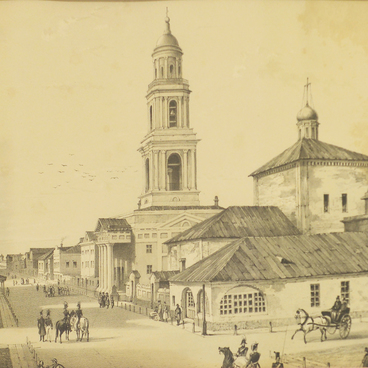This lithography shows the procession of the cross, during which the icon of the Theotokos of Smolensk of Seven Lakes was brought into the Kazan Kremlin. This tradition dated back to 1654, when the pestilence was rife in many Russian towns and cities, including Kazan. The death toll mounted to dozens or hundreds of thousands, according to different sources. The local believers regarded the disease as God’s punishment and brought the icon of the Mother of God from the Seven Lakes poustinia (desert) to Kazan. The epidemic subsided after the image had travelled around the walls of the city.
Bringing of the Icon Theotokos of Seven Lakes
Creation period
Late 1840s – early 1850s
Dimensions
49,3x66,3 cm
Technique
Lithography
Exhibition
1
Open in app#1
Peter Tabure
Bringing of the Icon Theotokos of Seven Lakes
#5
#6
Metropolitan Lavrenty of Kazan ordered to bring the icon from the monastery to Kazan from then on annually on June 26th (July 9th, under the new style calendar) in memory of the miracle. The wonderworking icon stayed for one month in the city and was to be brought to all Kazan churches.
#7
Annually the city newsletters published the list of churches, compiled by the Archbishop, where the icon of Seven Lakes would stay, and the calendar of religious processions, which the believers could join. Numerous pilgrims would come to Kazan, even from remote places, to venerate the icon. For example, 1914 saw over 50 thousand pilgrims.
#8
Such an influx of people had a beneficial effect on the financial situation of Kazan merchants. Some of them could gain as much as the whole year’s revenue within one day during that period.
#9
The Kazan administration had to take special measures to maintain order in the city. For example, the religious processions there were always accompanied by military and police officers in ceremonial full dress, who were to prevent congestion and help the clergy with the icon to move through the crowd.
#10
Peter Tabure captured the procession of the cross in his lithography in the middle of the 19th century. The Kazan engraver created it on the basis of the painting by N. Roz (the researchers have failed to identify the artist’s full name), The View of the meeting of the Theotokos of Smolensk in Kazan, 1845. The lithography shows how the icon is brought into the Kazan Kremlin from the Ivanovskaya Square.
#4
They stopped to observe the tradition associated with the Seven Lakes Icon after 1917. The Seven Lake monastery was destroyed and the icon itself was lost.
read morehide
00:00
00:00
1x
Bringing of the Icon Theotokos of Seven Lakes
Creation period
Late 1840s – early 1850s
Dimensions
49,3x66,3 cm
Technique
Lithography
Exhibition
1
Open in app
Share



